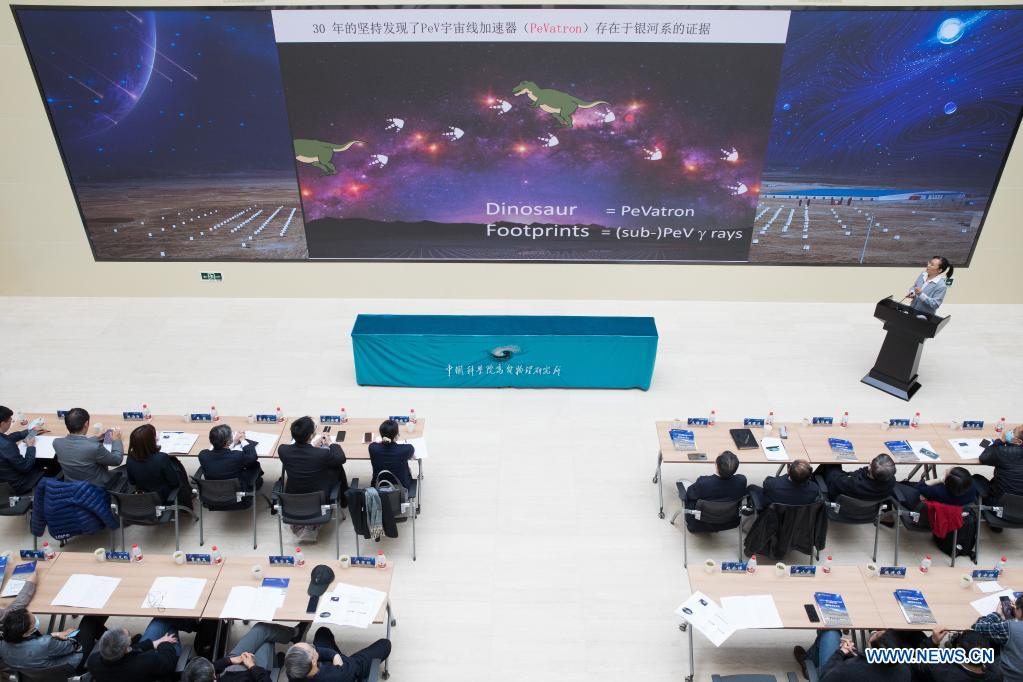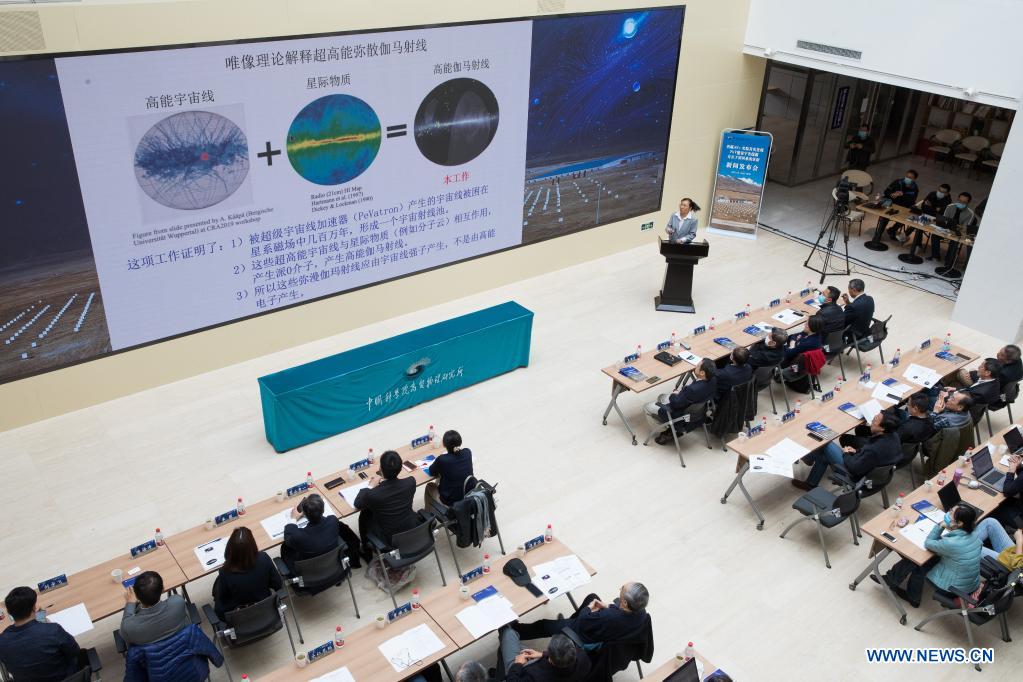

Researcher Huang Jing introduces the discovery during a news conference in Beijing, capital of China, April 2, 2021. The Tibet ASgamma experiment, a China-Japan joint research project, has detected that a supernova remnant may be the source of some ultrahigh-energy cosmic rays. Cosmic rays are high-energy particles that move through space at nearly the speed of light. It is believed that particles could be accelerated in PeVatron and reach a petaelectron volt (PeV), which creates 100 times more energy than the record high achieved by any human-made accelerator on Earth. Scientists have been trying to find these cosmic accelerators, hoping they could provide clues about how stars evolve and how energy is transported throughout the galaxy. No PeVatrons have been firmly detected yet. On Tuesday, a team of scientists from China and Japan reported in Nature Astronomy that they had identified supernova remnant SNR G106.3+2.7 as a potential PeVatron in our galaxy from the China-Japan Tibet ASgamma experiment. (Xinhua/Jin Liwang)

Researcher Huang Jing introduces the discovery during a news conference in Beijing, capital of China, April 2, 2021. The Tibet ASgamma experiment, a China-Japan joint research project, has detected that a supernova remnant may be the source of some ultrahigh-energy cosmic rays. Cosmic rays are high-energy particles that move through space at nearly the speed of light. It is believed that particles could be accelerated in PeVatron and reach a petaelectron volt (PeV), which creates 100 times more energy than the record high achieved by any human-made accelerator on Earth. Scientists have been trying to find these cosmic accelerators, hoping they could provide clues about how stars evolve and how energy is transported throughout the galaxy. No PeVatrons have been firmly detected yet. On Tuesday, a team of scientists from China and Japan reported in Nature Astronomy that they had identified supernova remnant SNR G106.3+2.7 as a potential PeVatron in our galaxy from the China-Japan Tibet ASgamma experiment. (Xinhua/Jin Liwang)

Wang Yifang, a Chinese Academy of Sciences (CAS) academician, speaks during a news conference in Beijing, capital of China, April 2, 2021. The Tibet ASgamma experiment, a China-Japan joint research project, has detected that a supernova remnant may be the source of some ultrahigh-energy cosmic rays. Cosmic rays are high-energy particles that move through space at nearly the speed of light. It is believed that particles could be accelerated in PeVatron and reach a petaelectron volt (PeV), which creates 100 times more energy than the record high achieved by any human-made accelerator on Earth. Scientists have been trying to find these cosmic accelerators, hoping they could provide clues about how stars evolve and how energy is transported throughout the galaxy. No PeVatrons have been firmly detected yet. On Tuesday, a team of scientists from China and Japan reported in Nature Astronomy that they had identified supernova remnant SNR G106.3+2.7 as a potential PeVatron in our galaxy from the China-Japan Tibet ASgamma experiment. (Xinhua/Jin Liwang)

Researcher Huang Jing introduces the discovery during a news conference in Beijing, capital of China, April 2, 2021. The Tibet ASgamma experiment, a China-Japan joint research project, has detected that a supernova remnant may be the source of some ultrahigh-energy cosmic rays. Cosmic rays are high-energy particles that move through space at nearly the speed of light. It is believed that particles could be accelerated in PeVatron and reach a petaelectron volt (PeV), which creates 100 times more energy than the record high achieved by any human-made accelerator on Earth. Scientists have been trying to find these cosmic accelerators, hoping they could provide clues about how stars evolve and how energy is transported throughout the galaxy. No PeVatrons have been firmly detected yet. On Tuesday, a team of scientists from China and Japan reported in Nature Astronomy that they had identified supernova remnant SNR G106.3+2.7 as a potential PeVatron in our galaxy from the China-Japan Tibet ASgamma experiment. (Xinhua/Jin Liwang)

86-10-68597521 (day)
86-10-68597289 (night)

52 Sanlihe Rd., Xicheng District,
Beijing, China (100864)

